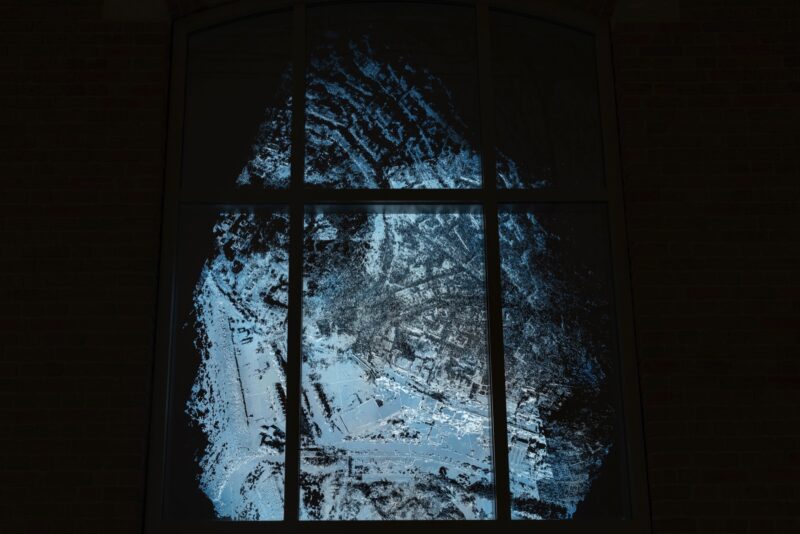[Summer 2021]
Gagnon-Forest, Séquence aérienne
Par Élisabeth Recurt
Maison de la culture Claude-Léveillée, Montréal
13.12.2020 — 14.02.2021
Here, the duo of Gagnon-Forest (Mathieu Gagnon and Mathilde Forest) presents a series of six large-format photographs (inkjet prints on film, backlit), articulated and paced by three dualities. Installed in the large windows on the lateral wall of Maison de la culture Claude-Léveillée, on Rue Boyer, three black-and-white photographs of topographic surveys alternate with three blue-shaded colour photographs of landscape elements.
The black-and-white images are based on 3D digitizations made by the City of Montreal using LiDAR low-altitude aerial technology. Gagnon-Forest then took over, using decoupage techniques and changes of viewing angles, lighting, and contrast. Three sectors of the city are portrayed, from left to right: Montréal-Nord, Villeray, and Ahuntsic.
Gagnon-Forest’s work falls at the intersection of visual arts (the training of both artists) and social sciences (Forest being a researcher associated with the Centre de recherche sur les innovations et transformations sociales). In response to issues that link space and the collective imagination, the duo’s work skilfully weaves connections between sociological and aesthetic concerns. The dichotomies of the photographic panorama subtly underlie a visual narrative emblematic of our various relationships with the real (documentary or fiction).
The topographic surveys reveal a cadastral plan inherent to the master plans that structure space and act as indications of citizens’ quality of life: predominance of urban layout designed for automobile mobility, narrow housing lots, limited access to nature, standardization of the built environment. Forest and Gagnon often ponder the “right” to space of citizens who have no choice but to suffer the constraints of urban living; for instance, the viewer can
observe certain infrastructure elements, indifferently implemented, that fracture the landscape, instilling a sense of compartmentalization among the population. These images are presented as documents, as referential truth: the neutrality of their appearance highlighted by a linear graphic design evokes both the New Topographics movement, objectively interested in urban developments (one thinks of Lewis Baltz) and the geometric abstraction aesthetic model of a Malevitch or Mondrian – all in ordered precision and exerted control.
In alternation and opposition with these geometrized spaces, meddling with them, are the three blue-shaded images bearing topographic traces upon which organic motifs are superimposed. This is a transition to an experience of withdrawal from the object observed. What do we perceive? Mountain? Unique relief feature? Stretches of water? Vegetation? It’s open to interpretation. The optical blurring provoked by the multiple layers in these images brings out the idea of transformation or ephemerality. These subjective compositions contrast with the objectivity of the digitized cadastral plans produced by the city. In the blue-shaded prints, the use of photogrammetry creates an instability of perception, an impermanence, due in part to the granular quality perceived as a veil dropped between reality and its image, fostering the emergence of an ambience that might be called evanescent, poetic. The fuzziness blurs the hierarchy of the plans and forms a screen between the object portrayed and the observer. These point-cloud effects are the presumed result of the use of digital photogrammetry. A technique based on the parallax effect of hundreds of different points of view of the same object produces three-dimensional representations. The captures, translated into fixed images, thus appear to be slightly disintegrated, offering unclear contours. The eye is confused, seeking reference points in an imaginary projection. Observed at nightfall during pandemic times, these prints also evoke a now-inaccessible elsewhere, to which the artists are witness.
In this panorama, the intrinsic qualities ascribed to images merge: informational quality (mimetic and indicial function, otherwise known as documentary, reinforced by the “anonymous” capture of topographies) and visual quality with fictive content. The documentary component is a common denominator of Forest-Gagnon’s work; archival documents embed referent and authenticated representation, uncovering a territorial identity that enables them to identify public policies. This interest overlaps with those of artists who are concerned about urban shifts, such as Melvin Charney, for whom social responsibility ruled over adaptable projects. Charney also reflected on the domination of the functional dimension over the social dimension in urban planning, and some of his works connected the real and fiction. Similarly, Séquence aérienne links sociological and poetic threads. Visual qualities and impacts are closely related to Forest-Gagnon’s sociological thesis – that of encouraging us to be more aware of our environment. Translated by Käthe Roth
Élisabeth Recurt is an art critic, college professor (art history, visual art), cultural columnist on CIBL radio, and long-time contributor to magazines such as ETC and Espace art actuel. She also writes fiction (poetry, novellas, stories).
[ See the magazine for the complete article and more images : Ciel variable 117 – SHIFTED ]


